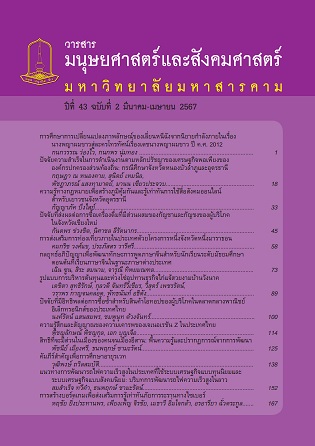การส่งเสริมการท่องเที่ยวภายในประเทศด้วยโครงการหนึ่งจังหวัดหนึ่งมาราธอน
Main Article Content
บทคัดย่อ
ปัญหาโรคระบาด Covid-19 ได้ส่งผลต่อภาคการท่องเที่ยวของประเทศที่มีอัตราการพึ่งพาการท่องเที่ยวจากต่างประเทศสูงอย่างประเทศไทย การศึกษานี้มีวัตถุประสงค์เพื่อศึกษาบทบาทของการจัดงานวิ่งมาราธอนต่อการท่องเที่ยวรายจังหวัด วิเคราะห์บทบาทของงานวิ่งมาราธอนต่อการท่องเที่ยวรายจังหวัด โดยใช้ข้อมูลการจัดการแข่งขันมาราธอนในช่วงปี 2565-2566 จาก SportStat Asia จำ นวน 41รายการใน 21 จังหวัด ทำ การวิเคราะห์ความแตกต่างรายคู่และวิเคราะห์สมการถดถอยเชิงซ้อน พบว่าอัตราการเข้าพัก จำ นวนผู้เข้าพัก จำ นวนผู้มาเยือน และรายได้จากการท่องเที่ยวของพื้นที่ที่จัดงานวิ่งเพิ่มขึ้นอย่างมีนัยสำ คัญทางสถิติในเดือนที่มีการจัดการแข่งขัน นอกจากนี้จำ นวนนักวิ่งที่เพิ่มขึ้นยังส่งผลต่อการขยายตัวของตัวชี้วัดทั้ง 4 ตัว นำ ไปสู่ข้อเสนอในเชิงวิชาการ และการนำ ไปใช้ประโยชน์ในการส่งเสริมให้แต่ละจังหวัดควรมีการจัดการแข่งขันวิ่งมาราธอน โดยมีธีมและช่วงเวลาการแข่งขันที่สอดคล้องกับอัตลักษณ์และฤดูการท่องเที่ยวของแต่ละจังหวัด ทำ ให้ได้ปฏิทินมาราธอนรายจังหวัดของประเทศไทยเพื่อเป็นข้อมูลในการประชาสัมพันธ์การท่องเที่ยวสำ หรับนักท่องเที่ยวที่สนใจในการแข่งขันกีฬาวิ่งมาราธอน
Article Details
เอกสารอ้างอิง
กระทรวงการท่องเที่ยวและกีฬา. (2563). สถิติด้านการท่องเที่ยว ปี 2563 (Tourism Statistics 2020).https://mots.go.th/news/category/592.
วรพงศ์ ภูมิบ่อพลับ. (2561). การท่องเที่ยวเชิงกีฬาโอกาสสำ หรับจังหวัดชายแดนใต้, 11 (2). ฉบับภาษาไทยมนุษยศาสตร์สังคมศาสตร์และศิลปะ,11 (2), 1793-1811.
พัฒนาวิไล อินใหม จเร วิชาไทย จิราลักษณ์ นนทารักษ์ บุณยวีร์ เอื้อศิริวรรณ ณัฏฐ์นิธิมา แจ้งประจักษ์และ อาณัติ วรรณศรี. (2562). รูปแบบการบริหารจัดการด้านการแพทย์ฉุกเฉินสำหรับการแข่งขันกีฬาระดับชาติในประเทศไทย. สำ นักวิจัยเพื่อการพัฒนาหลักประกันสุขภาพไทย(สวปก.) สถาบันวิจัยระบบสาธารณสุข (สวรส.).
ทรงศักดิ์ รักพ่วง. (2019). Social network of marathon runners. Journal of Social Development, 21(1), 95-114.
สุรสิทธิ์ อุดมธนวงศ์. (2019). อิทธิพลของแรงจูงใจที่ส่งผลต่อผลสัมฤทธิ์การท่องเที่ยวเชิงกีฬาจังหวัดภูเก็ต กรณีศึกษาอีเวนต์มาราธอน. วารสารสุทธิปริทัศน์, 33(106), 236-250.
Amkhamphai, A., Khawchaimaha, S., & Jaroenwanit, P. (2020). Sports Tourism DestinationManagement Model: Khon Kaen International Marathon Case Study. Journal of theAssociation of Researchers, 25(2), 283-300.
Ainiyah, N., Deliar, A., & Virtriana, R. (2016). The classical assumption test to driving factors of land cover change in the development region of northern part of west Java. The International Archives of Photogrammetry, Remote Sensing and Spatial Information Sciences, 41, 205.
Brida, J. G., Gómez, D. M., & Segarra, V. (2020). On the empirical relationship between tourism and economic growth. Tourism Management, 81, 104131.
Chin, N., Day, J., Sydnor, S., Prokopy, L. S., & Cherkauer, K. A. (2019). Exploring tourism businesses’ adaptive response to climate change in two Great Lakes destination communities. Journal of Destination Marketing & Management, 12, 125-129.
Constantin-Vlad, O., & Isabella-Cristiana, S. (2014). The Relation between Monetary Integration, the Economic Development of the Euro Area and Sports Performance. Procedia-Social and Behavioral Sciences, 117, 715-723.
Du Preez, M., & Lee, D. E. (2016). The economic value of the trans Baviaans mountain biking event in the Baviaanskloof mega-reserve, eastern cape, south africa: A travel cost analysis using count data models. Journal of outdoor recreation and tourism, 15, 47-54.
Fourie, J., & Santana-Gallego, M. (2022). Mega-sport events and inbound tourism: New data, methods and evidence. Tourism Management Perspectives, 43, 101002.
Gallardo-Albarrán, D. (2018). Health and economic development since 1900. Economics & Human Biology, 31, 228-237.
Gil-Alana, L. A., dos Santos Figueiredo, O. H., & Wanke, P. (2019). Structural breaks in Brazilian tourism revenues: Unveiling the impact of exchange rates and sports mega-events. Tourism Management, 74, 207-211.
Gratton, C., Shibli, S., & Coleman, R. (2005). The economics of sport tourism at major sports events. Sport Tourism Destinations, 233-247.
Hsu, H., & Lachenbruch, P. A. (2014). Paired t-test. Wiley StatsRef.
Kumar, N., & Kumar, R. R. (2020). Relationship between ICT and international tourism demand: A study of major tourist destinations. Tourism Economics, 26(6), 908-925.
Leeds, M. A., & Von Allmen, P. (2016). The economics of sports. Routledge.
Lei, W. S. C., & Lam, C. C. C. (2015). Determinants of hotel occupancy rate in a Chinese gaming destination. Journal of Hospitality and Tourism Management, 22, 1-9.
Leonandri, D., & Rosmadi, M. L. N. (2018). The role of tourism village to increase local community income. Budapest International Research and Critics Institute-Journal (BIRCI-Journal), 1(4), 188-193.
Lyon, J. D., & Tsai, C. L. (1996). A comparison of tests for heteroscedasticity. Journal of the Royal Statistical Society: Series D (The Statistician), 45(3), 337-349.
Qureshi, M. I., Hassan, M. A., Hishan, S. S., Rasli, A. M., & Zaman, K. (2017). Dynamic linkages between sustainable tourism, energy, health and wealth: Evidence from top 80 international tourist destination cities in 37 countries. Journal of cleaner production, 158, 143-155.
Shrestha, N. (2020). Detecting multicollinearity in regression analysis. American Journal of Applied Mathematics and Statistics, 8(2), 39-42.
Scholtz, M. (2019). Does a small community (town) benefit from an international event?. Tourism Management Perspectives, 31, 310-322.
Somnil, P., Sihanu, K., Ninsaeng, N., & Chaimanee, J. (2020). The influence of marketing mix on sport tourism promotion of the trail running events. Journal of Sports Science and Health, 21(2), 295-310.
Stankova, M., & Vassenska, I. (2015). Raising cultural awareness of local traditions through festival tourism. Tourism & Management Studies, 11(1), 120-127.
Wang, J., Huang, X., Gong, Z., & Cao, K. (2020). Dynamic assessment of tourism carrying capacity and its impacts on tourism economic growth in urban tourism destinations in China. Journal of Destination Marketing & Management, 15, 100383.
Winter, T. (2004). Landscape, memory and heritage: New year celebrations at Angkor, Cambodia. Current Issues in Tourism, 7(4-5), 330-345.
World Tourism Organization (UNWTO). (2020). COVID-19 and tourism | 2020: A year in review. online. UNWTO.
Yergeau, M. E. (2020). Tourism and local welfare: A multilevel analysis in Nepal’s protected areas. World Development, 127, 104744.
Zhang, J., & Wu, L. (2015). Modulation of the urban heat island by the tourism during the Chinese New Year holiday: a case study in Sanya City, Hainan Province of China. Science Bulletin, 60(17), 1543-1546.


